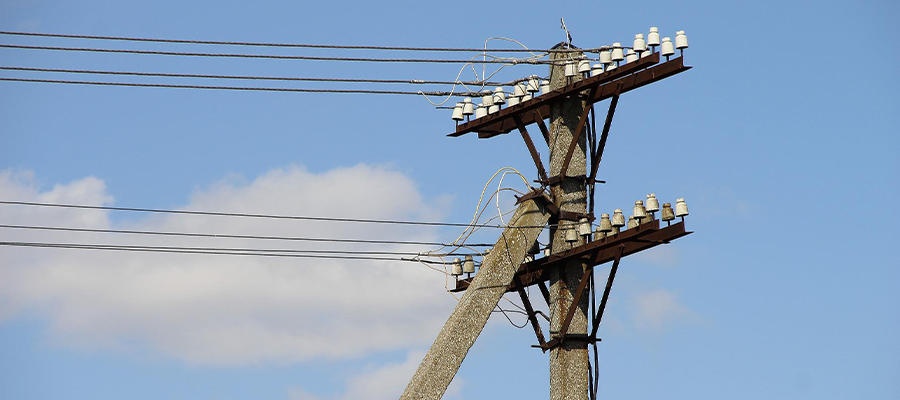Five-Minute Meeting: Step and Touch Potential

Step and touch potential refer to types of electrical hazards that can cause electrical shock injuries or electrocution. It’s crucial to consider the dangers of these hazards and take steps to prevent them from becoming emergencies.
Even if you do not touch a downed power line, you can still be electrocuted or suffer an electric shock injury. Some people believe that you must touch a downed power line to suffer electrical shock injury or electrocution, but the reality is, the ripple effect of the downed line’s electrical current on the ground poses extreme danger to everyone in the area since the human body is more conductive than the ground.
Being within 35 feet of a downed power line can cause electrocution, which is why so many first responders and family members are injured when they attempt to rescue people who have been injured in downed power line accidents. The concepts of step and touch potential explain how this can happen. For example, you can be injured by stepping into the power line’s electrical current or by touching an electrified object. Because line clearance arborists often work near power lines, more hazards exist than in trimming trees that aren’t near power lines. Step and touch potential explains how those hazards can turn to injuries.
Electricity follows the path of least resistance to reach the ground and can jump across an insulated object, given the right conditions. While it’s important to note that insulated tools and bucket trucks provide some measure of protection for workers, keeping tools in good condition and clean from dirt and moisture can further limit the potential of the tools becoming energized, since dirt and moisture have lower resistance to electric flow. This is the reason for air gaps between phases and the ground.
Table 3 in the ANSI Z.133 Safety Standard provides the minimum approach distance (MAD) chart for line clearance arborists to assist with maintaining safe distances from energized conductors while working. According to the table, as voltage increases along an electrical conductor, the minimum safe distance from that conductor also increases.

Step potential refers to the difference in voltages between your feet when standing near a downed power line and your feet when in different rings of electrical current. The difference in voltage between your feet can cause the electrical current to enter and surge through your body. When a power line is downed, it gives off an electrical current that “spills” onto the ground, flowing outward and away from the power, which subsequently creates a type of ripple effect. The voltage of the line’s current is higher near the power line and diminishes as it gets further away.
This ripple effect means that as you walk toward or away from a downed power line or any conductor of electricity, you are stepping into invisible rings of electric current with differing voltages. Each step can cause your feet to land in different rings. This can cause the electric current in one ring to enter your body through one leg on its path to find the ground, surge through your body, and exit through your other leg into the second ring of current.
Touch potential refers to the difference in voltage between an energized object or conductor and the feet of the person who is touching or otherwise contacting the object. The electric current of an energized object will flow through your hand, through your body, and out through your feet, and the voltage could be nearly the full voltage in the energized conductor.
The following steps can protect you from the dangers of step potential when in the vicinity of a downed power line:
- Shuffle away from the downed power line. This involves putting your feet together, keeping them in constant contact by always keeping them on the ground and shuffling so that one foot shuffles forward along the length of the other foot.
- Bunny-hop away from the downed power line. Put your feet together and hop out of the area while your feet are always together.
- Call 911.
- Call the power company.
If a downed power line has fallen onto your vehicle and you are inside, the following tips can help you stay safe from the hazards of step and touch potential:
- If you cannot drive away without going over the power line, stay in your vehicle until the power company arrives and a utility worker tells you that it is okay to exit the vehicle.
- If there is an impending emergency, such as a fire under the hood of your vehicle and you must immediately escape, keep in mind the dangers of step and touch potential.
- To protect against electrocution, do not touch the ground, the car’s metal door frame, or shell at the same time. Make sure you land with both feet together on the ground.
- Use the shuffle or bunny-hop methods to move away from the downed wire once you are safely out of the vehicle.
ACRT Arborist Training provides entry-level through advanced arborist classes and certifications for line clearance companies, government agencies, tree care companies, municipalities, and individuals around the nation.
SUBSCRIBE
Subscribe to our mailing list to receive updates.
Categories
Recent Posts
- How-To: Learning Knot Basics 02th Aug 2018
- How-To: Tying a Stopper knot 07th Aug 2018
- How-To: Selecting the Right Safety Vest 21th Aug 2018
- How-To: Tying a Slip Knot 04th Sep 2018
- How-To: Inspecting Your Snaps 18th Sep 2018
Training the Next Generation
All our classes are built on industry safety practices. Ready to start learning?